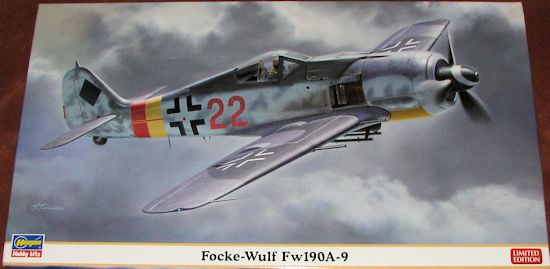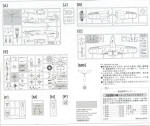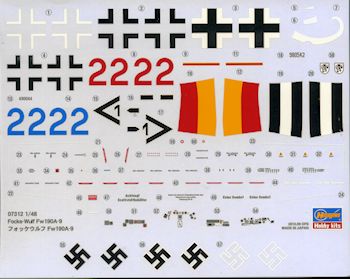
Hasegawa 1/48 FW-190A-9
| KIT #: | 07312 |
| PRICE: | $29.99 on sale ($58.99 SRP) |
| DECALS: | Two options |
| REVIEWER: | Scott Van Aken |
| NOTES: | Limited Reissue (2012) |

| HISTORY |
The Focke-Wulf Fw 190 Würger (Shrike) was a German single-seat, single-engine fighter aircraft designed by Kurt Tank in the late 1930s and widely used during World War II. Powered by a radial engine, the 190 had ample power and was able to lift larger loads than its well-known counterpart, the Messerschmitt Bf 109. The 190 was used by the Luftwaffe in a wide variety of roles, including day fighter, fighter-bomber, ground-attack aircraft and, to a lesser degree, night fighter.
When the Fw 190 started flying operationally over France in August 1941, it quickly proved itself to be superior in all but turn radius to the Royal Air Force's main front-line fighter, the Spitfire Mk. V. The 190 wrested air superiority away from the RAF until the introduction of the vastly improved Spitfire Mk. IX in July 1942 restored qualitative parity. The Fw 190 made its air combat debut on the Eastern Front in November/December 1942; though Soviet pilots considered the Bf 109 the greater threat, the Fw 190 made a significant impact. The fighter and its pilots proved just as capable as the Bf 109 in aerial combat, and in the opinion of German pilots who flew both, provided increased firepower and manoeuvrability at low to medium altitude.
The Fw 190 became the backbone of the Jagdwaffe (Fighter Force), along with the Bf 109. On the Eastern Front, the Fw 190 was versatile enough to use in Schlachtgeschwader (Battle Wings or Strike Wings), specialised ground attack units which achieved much success against Soviet ground forces. As an interceptor, the Fw 190 underwent improvements to make it effective at high altitude, enabling it to maintain relative parity with its Allied opponents. The Fw 190A series' performance decreased at high altitudes (usually 6,000 m (20,000 ft) and above), which reduced its effectiveness as a high-altitude interceptor, but this problem was mostly rectified in later models, particularly in the Junkers Jumo 213 inline-engine Focke-Wulf Fw 190D series, which was introduced in September 1944. In spite of its successes, it never entirely replaced the Bf 109.
The Fw 190 A-9 was the last A-model produced, and was first built in September 1944. The A-9 was fitted with the new BMW 801S, called the 801 TS or 801 TH when shipped as a more complete Triebwerksanlage version of the Kraftei or "power egg" concept, unitized engine installation (an aircraft engine installation format embraced by the Luftwaffe for a number of engine types on operational aircraft, in part for easy field replacement) rated at 2,000 PS (1,973 hp, 1,471 kW); the more powerful 2,400 PS (2,367 hp, 1,765 kW) BMW 801F-1 was still under development, and not yet available. The armour on the front annular cowling, which also incorporated the oil tank, was upgraded from the 6 mm (.24 in) on earlier models to 10 mm (.39 in). The 12-blade cooling fan was initially changed to a 14-blade fan, but it consumed more power to operate and did not really improve cooling; thus BMW reverted to the 12-blade fan. The A-9 cowling was slightly longer than that of the A-8 due to a larger annular radiator within the forward cowl for the oil system. The bubble canopy design with the larger head armour was fitted as standard. Three types of propeller were authorised for use on the A-9: the VDM 9-112176A wooden propeller, 3.5 m (11 ft 6 in) in diameter, was the preferred option, however, many A-9s were fitted with the standard VDM 9-12067A metal propeller and some had a VDM 9-12153A metal propeller with external, bolt on balance weights. The A-9 was also designed originally as an assault aircraft, so the wing leading edges were to have been armoured; however, this did not make it past the design stage in order to save weight. The A-9 was very similar to the A-8 in regards to the armament and Rüstsätze kits. A total of 910 A-9s were built between April 1944 and May 1945, mostly in Focke Wulf's Cottbus factor.
| THE KIT |
 As
some of you may know, Hasegawa's 1/48 FW-190s are pretty much the
Dragon kits of many years ago. Some have stated that Hasegawa made
some small improvements such as more positive main gear positioning
or an easier to assemble multi-piece engine cowling. Be that as it
may, the kit is very nice and has sold quite well under the Hasegawa
brand.
As
some of you may know, Hasegawa's 1/48 FW-190s are pretty much the
Dragon kits of many years ago. Some have stated that Hasegawa made
some small improvements such as more positive main gear positioning
or an easier to assemble multi-piece engine cowling. Be that as it
may, the kit is very nice and has sold quite well under the Hasegawa
brand.  ssembling
this piece. The A-9 has two major differences over the earlier A-8
and that is a 14 blade engine fan vice the normal 12 blade one and a
broader prop. These two items are included as metal parts and that
accounts for the higher price of the kit. For under the wing you
have only a drop tank as this version was not equipped for bombs.
Two different canopies are provided, which are different for each of
the markings options. This kit offers clear wing tip lights which
are simply inserted into holes in the tips.
ssembling
this piece. The A-9 has two major differences over the earlier A-8
and that is a 14 blade engine fan vice the normal 12 blade one and a
broader prop. These two items are included as metal parts and that
accounts for the higher price of the kit. For under the wing you
have only a drop tank as this version was not equipped for bombs.
Two different canopies are provided, which are different for each of
the markings options. This kit offers clear wing tip lights which
are simply inserted into holes in the tips. | CONCLUSIONS |
| REFERENCES |
http://en.wikipedia.org/wiki/Fw190
June 2013
My thanks to me for picking this one up on sale.
If you would like your product reviewed fairly and fairly quickly, please contact the editor or see other details in the Note to Contributors.
Back to the Previews Index Page